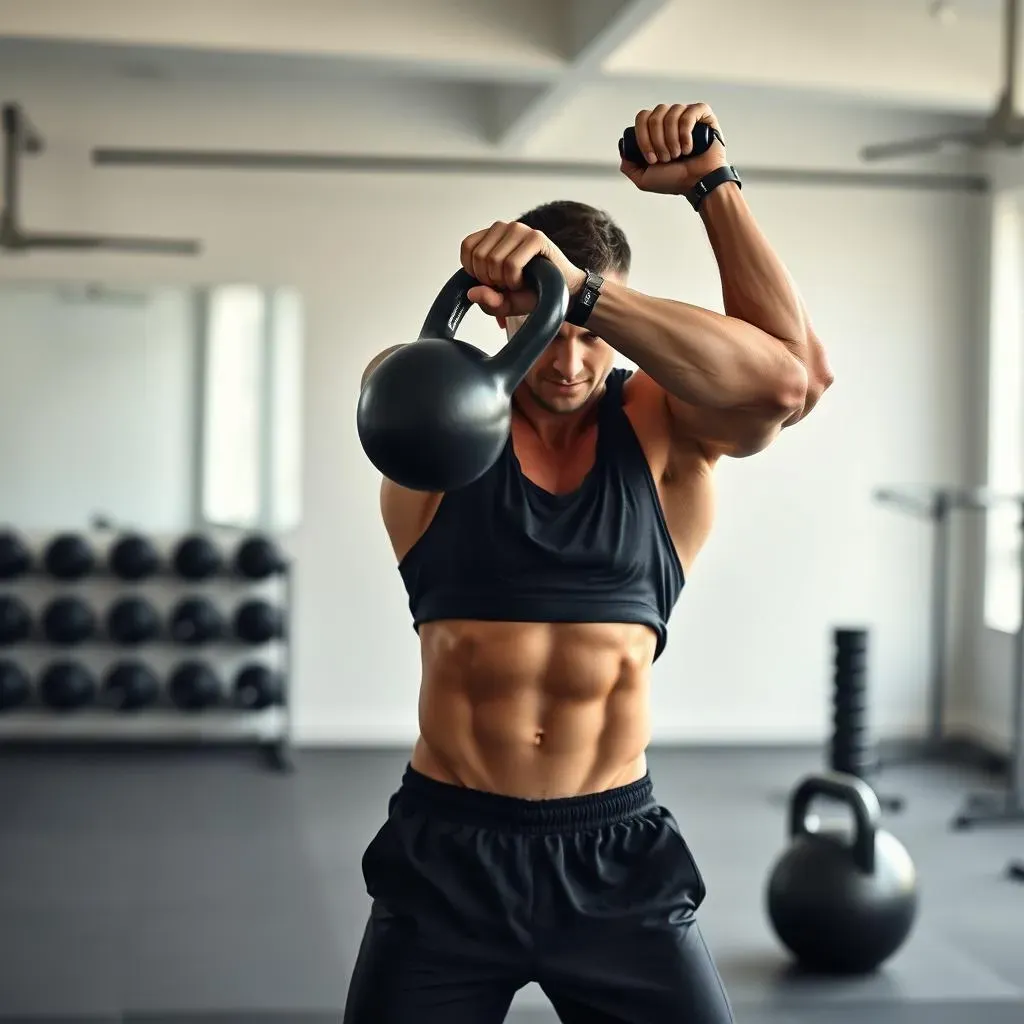Table of Contents
Ready to torch calories, build serious strength, and carve a lean physique? All you need is one trusty kettlebell and a commitment to just 30 minutes. This isn't your average workout – we're diving into a powerhouse full body single kettlebell workout designed to maximize every movement. Forget spending hours at the gym; this efficient routine hits every major muscle group, boosting your aerobic capacity while sculpting your body.
WarmUp: Preparing Your Body for the Kettlebell Challenge

WarmUp: Preparing Your Body for the Kettlebell Challenge
Alright, before we even think about picking up that kettlebell, let's talk warm-up. I cannot stress this enough: skipping the warm-up is like driving a car without oil – you're just asking for trouble. A proper warm-up primes your muscles, gets your blood flowing, and prepares your joints for the workout ahead. We want to focus on dynamic movements that mimic the exercises we'll be doing, but at a lower intensity. Think of it as waking up your body and telling it, "Hey, we're about to do some work, so get ready!"
For this full body single kettlebell workout, we're targeting all major muscle groups, so our warm-up needs to reflect that. I usually start with some light cardio, like jumping jacks or high knees, to get the heart rate up. Then, it's time for dynamic stretching and mobility work. Remember, we're not holding these stretches; we're moving through them.
Here's a sample warm-up routine I often use:
- Jumping jacks: 30 seconds
- High knees: 30 seconds
- Arm circles (forward and backward): 10 reps each direction
- Leg swings (forward and sideways): 10 reps each leg, each direction
- Torso twists: 10 reps each side
- Bodyweight squats: 10 reps
- Kettlebell halos (light weight or no weight): 5 reps each direction
I also like to incorporate some specific movements that directly relate to the kettlebell exercises we'll be doing. For example, before kettlebell swings, I'll do some hip hinges to activate my glutes and hamstrings. Before goblet squats, I'll do some bodyweight squats to get the quads firing.
Don't rush through this part! Spend at least 5-10 minutes properly warming up. Your body will thank you later. And trust me, a few extra minutes of preparation is worth avoiding potential injuries. Now that we're warmed up, let's move on to the foundation of our full body single kettlebell workout: the kettlebell swing.
Mastering the Kettlebell Swing: The Foundation of Your Full Body Workout

Mastering the Kettlebell Swing: The Foundation of Your Full Body Workout
Why the Kettlebell Swing is King
listen up, because this is crucial: if you're going to master one kettlebell exercise, make it the swing. Seriously, the kettlebell swing is the undisputed king of full-body movements. It's not just a great cardio exercise; it builds explosive power in your hips, strengthens your posterior chain (that's your glutes, hamstrings, and back), and even works your core. Plus, it's the foundation for so many other kettlebell exercises. If you can swing properly, you're already halfway to mastering cleans, snatches, and more.
Think of the kettlebell swing as a dynamic plank. You're not just lifting the weight with your arms; you're using your hips to generate power and drive the kettlebell forward. It's a hinge movement, not a squat. Your back should stay straight, and your core should be engaged throughout the entire movement. Trust me, once you nail the swing, you'll feel like a total badass.
Breaking Down the Swing: Technique is Everything
Alright, let's get down to the nitty-gritty of proper kettlebell swing technique. This isn't about just flailing around with a weight; it's about precision and control. Start with your feet shoulder-width apart, toes pointed slightly outward. The kettlebell should be a few inches in front of you.
Hinge at your hips, keeping your back straight, and reach for the kettlebell. Grip it firmly with both hands. Now, hike the kettlebell back between your legs, like you're snapping a towel. This is your backswing. From there, explosively drive your hips forward, squeezing your glutes and sending the kettlebell forward and up to about chest height.
Let the kettlebell swing back down between your legs, and repeat. The movement should be fluid and continuous. Remember, it's a hip hinge, not a squat. Your knees should bend slightly, but the primary movement should come from your hips.
Here's a quick checklist to keep in mind:
- Straight back: Avoid rounding your back.
- Engaged core: Keep your abs tight throughout the movement.
- Powerful hip drive: Use your glutes and hamstrings to generate power.
- Controlled movement: Don't let the kettlebell control you.
- Breathing: Exhale as you swing the kettlebell up, inhale as you swing it back down.
Common Mistakes and How to Fix Them
Now, let's talk about some common mistakes I see people make with kettlebell swings, and how to fix them. One of the biggest mistakes is squatting instead of hinging. This puts unnecessary stress on your knees and doesn't engage your posterior chain properly. To fix this, focus on pushing your hips back and keeping your back straight. Think about closing a car door with your butt.
Another common mistake is using your arms to lift the kettlebell. Your arms should be relaxed and act as guides, not as primary movers. The power should come from your hips. To fix this, focus on squeezing your glutes and driving your hips forward. Imagine you're trying to launch the kettlebell with your hips.
Also, many people round their backs during the swing. This is a recipe for injury. Keep your back straight and your core engaged throughout the entire movement. If you can't maintain a straight back, reduce the weight or practice the hip hinge movement with no weight.
Here's a table summarizing common mistakes and their fixes:
Mistake | Fix |
|---|---|
Squatting instead of hinging | Focus on pushing hips back, keep back straight |
Using arms to lift the kettlebell | Squeeze glutes, drive hips forward |
Rounding the back | Engage core, maintain straight back, reduce weight if needed |
The Ultimate Full Body Single Kettlebell Workout: Exercises and Execution

The Ultimate Full Body Single Kettlebell Workout: Exercises and Execution
The Core Four: Your Go-To Kettlebell Moves
Alright, now for the main event! This is where we put all that warm-up and swing practice to good use. I've curated a selection of exercises that, when combined, create a killer full body single kettlebell workout. We're focusing on compound movements that hit multiple muscle groups at once, maximizing efficiency and calorie burn. Trust me, you'll feel this one from head to toe.
I call these the "Core Four" because they're the foundation of this workout. We've got the Goblet Squat, the Three-Point Row, the Hang Clean and Push Press, and, of course, we're throwing in some good old Push-Ups for good measure. Each exercise complements the others, creating a synergistic effect that will leave you feeling strong, powerful, and ready to conquer anything. I'm excited just thinking about it!
Before we dive into the specifics, let's talk about sets, reps, and rest. I recommend aiming for 3-4 rounds of each exercise, with 8-12 reps per round. Rest for 60-90 seconds between rounds. But listen to your body! If you need more rest, take it. The goal is to push yourself, but not to the point of injury.
Exercise Breakdown: Form and Function
let's break down each exercise and talk about proper form. Remember, form is paramount. It's better to do fewer reps with good form than to crank out a bunch of reps with sloppy technique. Trust me, your body will thank you in the long run.
Goblet Squat
Hold the kettlebell close to your chest, like you're cradling a baby (hence the name "goblet"). Stand with your feet shoulder-width apart, toes pointed slightly outward. Squat down as low as you can while maintaining a straight back and keeping your heels on the ground. Push through your heels to stand back up. This exercise targets your quads, glutes, and core.
Three-Point Row
Place one hand on a bench or stable surface for support. Hinge at your hips, keeping your back straight, and let the kettlebell hang down. Row the kettlebell up towards your chest, squeezing your shoulder blades together. Lower the kettlebell back down with control. This exercise targets your back, biceps, and shoulders.
Hang Clean and Push Press
Start with the kettlebell between your legs, like you're about to do a swing. Hike the kettlebell back and then explosively drive your hips forward, pulling the kettlebell up towards your chest. As the kettlebell reaches your chest, flip your wrist and catch it in the "rack" position (kettlebell resting on your forearm). From there, press the kettlebell overhead, locking out your arm. Lower the kettlebell back down to the rack position and then back down to the starting position. This exercise targets your entire body, with an emphasis on your shoulders, core, and legs.
Push-Ups
Get into a plank position with your hands shoulder-width apart. Lower your chest towards the ground, keeping your body in a straight line. Push back up to the starting position. This exercise targets your chest, shoulders, and triceps. If regular push-ups are too difficult, you can do them on your knees.
Here's a quick reference table for the exercises:
Exercise | Target Muscles | Reps | Sets |
|---|---|---|---|
Goblet Squat | Quads, Glutes, Core | 8-12 | 3-4 |
Three-Point Row | Back, Biceps, Shoulders | 8-12 (per side) | 3-4 |
Hang Clean and Push Press | Full Body | 8-12 | 3-4 |
Push-Ups | Chest, Shoulders, Triceps | As many as possible (AMRAP) | 3-4 |
Progressing Your Kettlebell Training: Variations and Intensity

Progressing Your Kettlebell Training: Variations and Intensity
So, you've nailed the basics, you're crushing the Core Four, and you're feeling like a kettlebell ninja. Now what? Well, that's where progressing your kettlebell training comes in. I never want you to get bored or plateau, so it's time to spice things up and challenge your body in new ways. We're going to explore variations of the exercises we've already learned, as well as ways to increase the intensity to keep you growing stronger and more powerful. Think of it as unlocking new levels in your kettlebell journey!
There are two main ways to progress: variations and intensity. Variations involve changing the exercises themselves to target different muscles or movement patterns. Intensity involves increasing the difficulty of the exercises, either by adding weight, increasing reps, or decreasing rest time. The key is to find the right balance between the two to keep challenging yourself without overdoing it. I always like to experiment and see what works best for my body.
Kettlebell Exercise Variations: Mixing It Up
Variations are your secret weapon against boredom and plateaus. By changing the exercises slightly, you can target different muscles, improve your stability, and challenge your coordination. I love experimenting with variations to keep things fresh and exciting.
For example, instead of regular goblet squats, try doing single-leg goblet squats. This variation increases the challenge to your balance and stability, while also targeting your quads and glutes more intensely. Or, instead of regular three-point rows, try doing renegade rows, where you're in a plank position while rowing the kettlebell. This variation adds a core stability challenge to the exercise.
Here are some other kettlebell exercise variations to try:
- Kettlebell Swings: American Swings (overhead), One-Arm Swings
- Goblet Squats: Single-Leg Goblet Squats, Goblet Squat with a Twist
- Three-Point Rows: Renegade Rows, Inverted Rows
- Hang Clean and Push Press: Kettlebell Thrusters, Alternating Clean and Press
- Push-Ups: Diamond Push-Ups, Decline Push-Ups
I recommend trying one or two new variations each week to keep things interesting. Just make sure you master the basic movement before attempting the variation. And always listen to your body! If something doesn't feel right, don't force it.
Ramping Up the Intensity: Pushing Your Limits
Once you've mastered the basic exercises and their variations, it's time to focus on increasing the intensity. This is where you really start to see results in terms of strength, power, and muscle growth. There are several ways to increase the intensity of your kettlebell training.
One of the most obvious ways is to simply add more weight. If you're consistently doing 12 reps of an exercise with good form, it's time to grab a heavier kettlebell. Just make sure you can still maintain proper form with the heavier weight. Another way to increase the intensity is to increase the number of reps. Instead of doing 8-12 reps, try doing 15-20 reps. This will increase the time under tension and challenge your muscular endurance.
You can also decrease the rest time between sets. Instead of resting for 60-90 seconds, try resting for only 30-45 seconds. This will increase the cardiovascular demand of the workout and challenge your mental toughness. Finally, you can try combining variations and intensity techniques. For example, you could do single-leg goblet squats with a heavier kettlebell and shorter rest times. This will create a super-challenging workout that will push you to your limits.
Here's a table summarizing different ways to increase intensity:
Technique | Description | Benefits |
|---|---|---|
Increase Weight | Use a heavier kettlebell | Builds strength and power |
Increase Reps | Perform more repetitions per set | Improves muscular endurance |
Decrease Rest Time | Reduce the rest time between sets | Increases cardiovascular demand |
Combine Techniques | Use variations and intensity techniques together | Creates a super-challenging workout |
CoolDown and Recovery: Maximizing the Benefits of Your Full Body Single Kettlebell Workout

CoolDown and Recovery: Maximizing the Benefits of Your Full Body Single Kettlebell Workout
Why Cool-Down and Recovery Matter
Alright, listen up, because this is just as important as the workout itself! I see so many people skip the cool-down and recovery, and it drives me nuts. You've just put your body through a tough full body single kettlebell workout, and now it's time to help it recover and rebuild. Think of it as giving your body a big hug and saying, "Thanks for working so hard, I'm going to take care of you now."
Cooling down helps gradually lower your heart rate and blood pressure, preventing dizziness and lightheadedness. It also helps remove metabolic waste products from your muscles, reducing soreness and stiffness. Recovery, on the other hand, is about replenishing your energy stores and repairing muscle damage. It's a combination of nutrition, hydration, and rest. Trust me, if you prioritize cool-down and recovery, you'll feel better, perform better, and reduce your risk of injury.
The Ultimate Cool-Down Routine
So, what does a good cool-down routine look like? Well, I like to start with some light cardio, like walking or jogging, to gradually lower my heart rate. Then, it's time for static stretching. Unlike dynamic stretching, which we do during the warm-up, static stretching involves holding each stretch for 30-60 seconds. This helps improve flexibility and reduce muscle tension.
Focus on stretching the muscles you used during the workout. For this full body single kettlebell workout, that means stretching your quads, hamstrings, glutes, back, shoulders, and chest. I also like to incorporate some foam rolling to release any knots or tight spots in my muscles. Foam rolling can be a little uncomfortable at first, but it's so worth it.
Here's a sample cool-down routine I often use:
- Walking or jogging: 5 minutes
- Quad stretch: 30 seconds per leg
- Hamstring stretch: 30 seconds per leg
- Glute stretch (figure four): 30 seconds per leg
- Back stretch (cat-cow): 10 reps
- Shoulder stretch (across the body): 30 seconds per arm
- Chest stretch (doorway stretch): 30 seconds
- Foam rolling: 5-10 minutes (focus on quads, hamstrings, glutes, and back)
Recovery Strategies: Fueling Your Body and Mind
Cool-down is just the first step. Now it's time to focus on recovery. This is where nutrition, hydration, and rest come into play. After a tough workout, your body needs to replenish its energy stores and repair muscle damage. That means eating a balanced meal with plenty of protein and carbohydrates.
Protein is essential for muscle repair and growth, while carbohydrates replenish your glycogen stores (your body's primary source of energy). I also like to add some healthy fats to my post-workout meal to help reduce inflammation. Don't forget to hydrate! Drink plenty of water or a sports drink to replace the fluids you lost during the workout. Dehydration can impair muscle recovery and performance.
And last but not least, get enough sleep! Sleep is when your body does most of its repairing and rebuilding. Aim for 7-9 hours of quality sleep per night. If you're serious about maximizing the benefits of your full body single kettlebell workout, you need to prioritize sleep.
Here's a table summarizing key recovery strategies:
Strategy | Description | Benefits |
|---|---|---|
Nutrition | Eat a balanced meal with protein, carbs, and healthy fats | Replenishes energy stores, repairs muscle damage |
Hydration | Drink plenty of water or a sports drink | Replaces fluids, prevents dehydration |
Sleep | Aim for 7-9 hours of quality sleep per night | Repairs and rebuilds muscle tissue |
Your Full Body Single Kettlebell Workout: The Takeaway
You've just unlocked a powerful tool for transforming your fitness with this full body single kettlebell workout. Remember, consistency is key. Stick with this routine, focusing on proper form and gradually increasing the weight or reps as you get stronger. Whether your goal is to build muscle, burn fat, or simply improve your overall fitness, the kettlebell is a versatile and effective weapon in your arsenal. Now go forth, swing strong, and enjoy the results of your hard work!